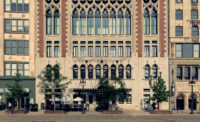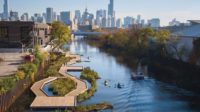Chicago’s hotel boom has provided a major boost for historic preservation, breathing new life into aging downtown buildings designed by such legendary firms as D.H. Burnham & Co., Holabird & Root, Jenney & Mundie, and Rapp & Rapp. Now the trend has expanded beyond the Loop, turning a tiny Art Deco office building in the hip Wicker Park neighborhood into a boutique hotel, the Robey. Yet this conversion does more than save the brick and Indiana limestone skin of this charming flatiron building. It departs from the boutique hotel norm of the aggressively decorated, historically themed interior, opting instead for an understated, curated approach that layers the new on the old and effectively fuses influences from both sides of the Atlantic.
Additional Information:Jump to credits & specifications
Designed by Chicago architects Perkins, Chatten & Hammond and originally called the North West Tower, the 12-story skyscraper was shaped by the six-corner intersection on which it sits, as well as a desire to bring a touch of downtown grandeur to a neighborhood business district. “The Skyscraper Leaves the Loop,” proclaimed the February 1929 issue of The Greater Chicago Magazine, reflecting the exuberance that prevailed before that year’s devastating stock market crash. In the characteristic Chicago manner, structurally expressive brick piers shot skyward, leavened by patterned concrete spandrels that extended the building’s concrete frame. A copper-roofed cupola, illuminated by floodlights, was the cherry on top of this “roaring 20s” party cake.
Despite Wicker Park’s recent rise, the North West Tower fell into disrepair and was shrouded in scaffolding, after a developer’s idea to revive it as a boutique hotel failed because of financial difficulties. That changed in 2012 when the parent company of Chicago-based Convexity Properties bought the tower with a new plan for reinventing it as a hotel, then selected Mexico City–based Grupo Habita to spearhead redevelopment and operate the concern. Grupo Habita, whose first American property is the Hotel Americano in Manhattan’s Chelsea district (RECORD, December 2011), needed to respectfully restore the tower’s critical features so the owners could reap federal and local tax credits. Yet the company also charged a team of architects to produce something more stirring than an Art Deco period piece.
For the exterior restoration, Chicago-based architect of record Antunovich Associates repaired the buckling brick and crumbling spandrels, buffed limestone panels, restored glass to the boarded-up cupola, and installed new windows that replicate the appearance of the old ones. To temper the racket produced by the Chicago Transit Authority’s Blue Line elevated train, which connects to O’Hare International Airport and has a station next door, the designers specified sound-buffering windows for several guest rooms on the third through fifth floors. By restoring large storefront windows at the base, they created a see-through corner restaurant, Café Robey, which evokes Edward Hopper’s “Nighthawks,” minus that iconic painting’s mysterious gloom.
The revamped interior combines meticulous historic preservation with inventive insertions that reflect the hand of the interior architects, Nicolas Schuybroek Architects and Marc Merckx Interiors, both based in Belgium, as well as that of Antunovich. The team has handsomely restored the elevator lobby, a high-ceilinged space with pearl-gray and green marble, bronze elevator doors, and still-operating vintage arrow floor indicators. Several guest-floor corridors retain the original marble wainscoting. Even the hotel’s name reprises an earlier name of one of the streets that forms the six-corner intersection. “I did not want to impose anything on a building so strong, so emblematic of the neighborhood. The challenge was to maintain its identity,” says Schuybroek.
Yet the design team has enlivened, rather than entombed, the old skyscraper, which now expresses layers of time rather than a single era. In the Robey’s 69 guest rooms, ranging from expansive corner suites to smaller aeries of about 280 square feet, the architects inserted frosted wire glass partition walls that draw daylight into large bathrooms and evoke the building’s original office doors. At the same time, new elements, such as custom-designed furniture and stainless-steel supports for bedside ledges, introduce Midcentury Modern and contemporary design motifs. There’s no straining for effect here—just a muted elegance and a sense of expansiveness that comes from having a unique, slightly distant perspective on the downtown skyline. “Every room is organized so it has a beautiful view,” Marc Merckx says.
The best vistas are glimpsed from the Robey’s rooftop bar, Up & Up, which required an extension of the elevator shaft. A low-slung metal-and-glass pavilion holds this quietly exhilarating space, which is compressed by a wood ceiling that effectively frames the horizontal expanse of the cityscape outside. The pavilion is set back from the parapet, leaving room for a terrace and ensuring that the new does not alter the profile of the old when the Robey is seen from street level. In a previously unused space below the cupola, the architects created a grotto-like lounge for six to eight people that’s enlivened by hanging brass light fixtures inspired by Belgian interior architect Jules Wabbes.
In a related project next door, Grupo Habita, Antunovich, and French design studios Cigue and Delordinaire have transformed an old cold-storage warehouse into the Hollander, an upscale hostel that shares a swimming pool with the Robey. Yet pride of place here clearly is the Robey’s. With its compelling combination of historic authenticity and multilayered modernity, the hotel simultaneously grows organically from its neighborhood and brings something fresh to it.
CreditsArchitect: Nicholas Schuybroek Architects
Interior Architecture: Marc Mercx Interiors
Nicholas Schuybroek
Architect of Record: Antunovich Associates, Inc
Engineers Structural Engineer: Forefront Structural Engineers, Inc.
Lighting Designer: Filament 33
General contractor: Pepper Construction Group, LLC
Photographer: Photography by Adrian Gaut/Courtesy of Grupo Habita
Owner: DRW Real Estate Investments 540 W. Madison, Suite 2500 Chicago, Illionois 60661
Developer: Convexity Properties 540 W. Madison, Suite 2500 Chicago, Illinois 60661 (312) 542-3155
Operator: Grupo Habita, Mexico City Contact: Rafael Micha +52 (55) 5280-1813
|
SpecificationsFurniture: Custom bed frames, benches, dining tables, bedside tables and other furniture pieces: St. Damasse (Montreal, Quebec Canada) Knoll Living Divani Vintage: varoius Zachary A. Design: exterior concrete tables
Fabrics / Wallcoverings: Arc Com Valley Forge Pindler & Pindler Carnegie Fabrics P / Kaufmann
Carpets / Flooring: Nurazzo: custom terrazzo bathroom floor tile / Café Robey lounge floor tile Custom herringbone hardwood floor – Café Robey
Lighting: RH Restoration Hardware: GR bathroom vanity light Schoolhouse Electric Custom (Rareform and Meadow): various Vintage: various Rejuvination push-button light switches
Bathroom Fittings: Waterworks Highgate: Lavatory faucets and Shower heads Duravit: GR toilets
Artwork: Original architectural prints on linen (Perkins, Chatten & Hammond)
Technology: Revo Supersignal radios. Enseo in-room entertainment system Lutron (public areas)
Other products / materials / amenities: Le Labo bath products |













Post a comment to this article
Report Abusive Comment